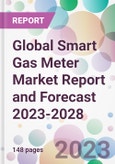According to the report the global smart gas meter market reached a value of USD 2.96 billion in 2022. Aided by the surging emphasis on energy efficiency and the increasing adoption of IoT in utilities management, the market is projected to further grow at a CAGR of 4.8% between 2023 and 2028 to reach a value of USD 3.92 billion by 2028.
Smart gas meters are modern devices that measure and record gas consumption in residential, commercial, or industrial premises. They differ from traditional gas meters by providing real-time data to both utility providers and consumers. This data-driven approach facilitates more accurate billing, demand forecasting, and aids in timely detection of leaks or anomalies in the gas supply.
A driving force behind the global smart gas meter market growth is the intensifying global focus on energy conservation. As countries strive to reduce their carbon footprints and optimise energy usage, there is an increasing shift towards smart meters as a means to achieve these goals. They allow utility companies to manage their resources more effectively and empower consumers with the tools to monitor and control their gas consumption.
The integration of the Internet of Things (IoT) in utility management has dramatically revolutionised the market outlook. With IoT, these meters can remotely transmit data, allow for over-the-air updates, and integrate seamlessly with other smart home systems. This connectivity not only ensures accurate and real-time monitoring but also offers predictive maintenance, reducing costs associated with manual meter readings and system breakdowns.
Furthermore, consumer awareness and preferences are playing a pivotal role in shaping the smart gas meters market size. As consumers become more tech-savvy and environmentally conscious, the demand for transparent, efficient, and sustainable energy consumption solutions has surged. The ability of smart gas meters to provide detailed consumption patterns allows consumers to make informed decisions and adapt behaviours to ensure efficient energy use.
Industrial applications of smart gas meters have also observed an upswing. Industries with significant gas consumption are looking for solutions to monitor, manage, and minimise their gas usage. Smart gas meters, with their real-time data collection and analytics capabilities, are becoming essential tools for industries aiming to achieve these objectives.
Regulatory frameworks and government initiatives further bolster the smart gas meters market demand. Many governments worldwide, recognising the potential benefits in terms of energy conservation, reduced operational costs, and enhanced consumer satisfaction, are either mandating or incentivising the rollout of smart gas meters.
In the forthcoming years, advancements in AI and machine learning are anticipated to play a pivotal role in the evolution of smart gas meters. These technologies could enhance predictive analytics capabilities, enabling utility providers to forecast demand with even greater accuracy and potentially leading to dynamic pricing models based on real-time demand and supply.
Market Segmentation
The market can be divided based on technology, type, component, end use, and region.
Market Breakup by Technology
- Automatic Meter Reading (AMR)
- Advanced Metering Infrastructure (AMI)
Market Breakup by Type
- Smart Ultrasonic Gas Meter
- Smart Diaphragm Gas Meter
Market Breakup by Component
- Hardware
- Software
Market Breakup by End Use
- Residential
- Commercial
- Industrial
Market Breakup by Region
- North America
- Europe
- Asia Pacific
- Latin America
- Middle East and Africa
Competitive Landscape
The report looks into the market shares, plant turnarounds, capacities, investments, and mergers and acquisitions, among other major developments, of the leading companies operating in the global smart gas meter market. Some of the major players explored in the report are as follows:
- Sehaj Synergy Technologies Pvt. Ltd.
- Honeywell International Inc.
- Diehl Stiftung & Co. KG
- Sensus
- Itron Inc.
- Others
About the Publisher
Acquire unparalleled access to critical industry insights with our comprehensive market research reports, meticulously prepared by a team of seasoned experts. These reports are designed to equip decision-makers with an in-depth understanding of prevailing market trends, competitive landscapes, and growth opportunities.
Our high-quality, data-driven analyses provide the essential framework for organisations seeking to make informed and strategic decisions in an increasingly complex and rapidly evolving business environment. By investing in our market research reports, you can ensure your organisation remains agile, proactive, and poised for success in today's competitive market.
Don't miss the opportunity to elevate your business intelligence and fortify your strategic planning. Secure your organisation's future success by acquiring one of these reports today.
*The publisher always strives to provide you with the latest information. The numbers in the article are only indicative and may be different from the actual report.
Table of Contents
1 Preface2 Report Coverage - Key Segmentation and Scope
Companies Mentioned
- Sehaj Synergy Technologies Pvt. Ltd.
- Honeywell International Inc.
- Diehl Stiftung & Co. KG
- Sensus
- Itron Inc.
Methodology

LOADING...
Table Information
| Report Attribute | Details |
|---|---|
| No. of Pages | 148 |
| Published | August 2023 |
| Forecast Period | 2023 - 2028 |
| Estimated Market Value ( USD | $ 3.1 Billion |
| Forecasted Market Value ( USD | $ 3.92 Billion |
| Compound Annual Growth Rate | 4.8% |
| Regions Covered | Global |
| No. of Companies Mentioned | 5 |









